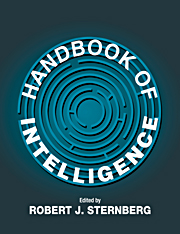Book contents
- Frontmatter
- Contents
- Preface
- Contributors
- PART I THE NATURE OF INTELLIGENCE AND ITS MEASUREMENT
- 1 The Concept of intelligence
- 2 History of Theories and Measurements of intelligence
- 3 Contemporary Models of Intelligence
- PART II DEVELOPMENT OF INTELLIGENCE
- PART III GROUP ANALYSES OF INTELLIGENCE
- PART IV BIOLOGY OF INTELLIGENCE
- PART V INTELLIGENCE AND INFORMATION PROCESSING
- PART VI KINDS OF INTELLIGENCE
- PART VII TESTING AND TEACHING INTELLIGENCE
- PART VIII INTELLIGENCE, SOCIETY, AND CULTURE
- PART IX INTELLIGENCE IN RELATION TO ALLIED CONSTRUCTS
- Author Index
- Subject Index
2 - History of Theories and Measurements of intelligence
Published online by Cambridge University Press: 05 June 2012
- Frontmatter
- Contents
- Preface
- Contributors
- PART I THE NATURE OF INTELLIGENCE AND ITS MEASUREMENT
- 1 The Concept of intelligence
- 2 History of Theories and Measurements of intelligence
- 3 Contemporary Models of Intelligence
- PART II DEVELOPMENT OF INTELLIGENCE
- PART III GROUP ANALYSES OF INTELLIGENCE
- PART IV BIOLOGY OF INTELLIGENCE
- PART V INTELLIGENCE AND INFORMATION PROCESSING
- PART VI KINDS OF INTELLIGENCE
- PART VII TESTING AND TEACHING INTELLIGENCE
- PART VIII INTELLIGENCE, SOCIETY, AND CULTURE
- PART IX INTELLIGENCE IN RELATION TO ALLIED CONSTRUCTS
- Author Index
- Subject Index
Summary
FRANCIS GALTON
Just 6 years after the publication in 1859 of Darwin's On the Origin of Species, his cousin Francis Galton published two articles in Macmillan's Magazine jointly entitled “Hereditary Talent and Character.” These articles were expanded into a book published in 1869 on hereditary genius. Galton's book combined Darwin's ideas about natural selection with the work of the Belgian statistician Quetelet (1849). Galton argued that genius is a normally distributed and heritable characteristic of humans. Galton believed in racial hierarchies. He argued that the ancient Greeks were as superior to his English contemporaries in their capacity for genius as his contemporaries were superior to Africans and their American descendants.
Galton's Measurement of Simple Processes
Galton established a laboratory in the South Kensington Museum of London in 1882 for the measurement of individual differences. For a small fee, visitors to the museum were given a battery of tests designed to measure auditory and visual sensory discrimination abilities as well as reaction times to stimuli and the ability to exert hand-squeeze pressure on a dynamometer. The choice of measures was influenced by the beliefs of the British empiricist philosophers about the importance of knowledge derived from sensations as a foundation for complex cognitive functioning and by a belief held by Galton that the sensory discriminative capacities of idiots are impaired. He assumed that individuals with high intelligence would have keener discriminative capacities than individuals with low intelligence (Galton, 1883).
Information
- Type
- Chapter
- Information
- Handbook of Intelligence , pp. 16 - 33Publisher: Cambridge University PressPrint publication year: 2000
Accessibility standard: Unknown
Why this information is here
This section outlines the accessibility features of this content - including support for screen readers, full keyboard navigation and high-contrast display options. This may not be relevant for you.Accessibility Information
- 39
- Cited by
